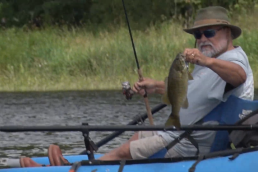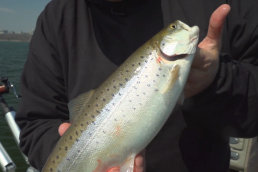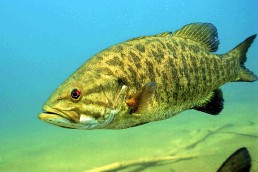Fishing the Spring White Bass River Runs
SHARE THIS POST
Old-timer wisdom states that “blooming lilac bushes signal the white bass run.” We now know it all depends on water temperatures, and follows hot-on-the-heels of the spring walleye run. And what’s not to love about white bass? They’re found in good numbers, eager to bite, and hitting live bait, jigs, spinners and flies all with equal enthusiasm. Catching them doesn’t require fancy tackle; anything from a Snoopy pole to a Sage fly rod will suffice. Oftentimes, walleyes, pike or catfish will also bite along with the white bass, Shore as well as boat anglers usually get a shot at catching them, too.
White bass have a very high reproductive rate. Large females can carry up to 1 million eggs. Spawning occurs when water temperatures reach the low- to mid-50-degree range, in slack water or the shallows. The fertilized eggs then stick to gravel, rocks and logs, and hatch within 2 to 3 days. White bass fry grow fast, some reaching a length of 8 to 9 inches their first year. Limits on white bass tend to be as liberal as it gets, with no closed season or bag limit on inland waters, or the Wisconsin River and Wolf/Winnebago system.
Hungry white bass in the rivers have saved many a spring walleye fishing trip when the run suddenly ended. They also offer an opportunity to keep a few fish for a fish fry, guilt-free. With 2020’s new, more restrictive 3-fish bag limit needed to protect the walleye fishery, white bass can still provide some great eating!
Where to find white bass: All the major river systems in Wisconsin have great populations of whites. I’ve personally caught them out of the Fox, Rock, Wolf, Mississippi and Wisconsin Rivers. Look for schools of fish near or on gravel bars, structure, around slack water or in eddies. The Wolf/Winnebago system is probably the most widely known fishery, with Fremont, WI claiming the title of “White bass Capital of Wisconsin.” Partridge Lake near Fremont holds lots of post-spawn white bass. My son Adam and I ran into a huge school there that had pushed minnows up against a rock wall. We quickly switched from river rigs to spinners and put 16 nice whites in the boat in a matter of minutes.
The downside of river white bass runs can be getting the timing right. A matter of a few days can make a big difference. Check local fishing reports from resorts or bait shops to get an idea how, where and when the fish are hitting. Boat traffic on the rivers during the run can be hectic on the weekends, so I suggest trying to fish during the week, if possible.
Baits: Minnows are probably the most popular live bait for white bass, with nightcrawlers and red worms running a close second. The classic presentation for live bait is the famous Wolf River Rig: a three-way swivel, with a 1-ounce sinker on the dropper line, and about 18 inches of line leading to a size 4 or 6 hook. Fish the rig deadsticked, or cast out into the current and slowly retrieved.
Are you enjoying this post?
You can be among the first to get the latest info on where to go, what to use and how to use it!
Small, 1/16-ounce bucktails or tube jigs tied in tandem, spinners, small crank baits and spoons will also catch fish. Cast towards shore and work the jig back out into the river. Take your time; try to imitate a small baitfish being swept out into the river.
I did really well on white bass last year using a tiny Mr. Champ spoon on which I usually catch Lake Michigan perch. All I did was cast towards a logjam, let the spoon sink for a few seconds, and slowly jig it in the current. White bass are known for hitting baits at full speed! If you hit one, take note of the location and depth; odds are the one you caught wasn’t alone.
White bass sometime get a bad rap for eating quality. I say nonsense. Generally, a white bass from the spring run is no more “fishy” tasting than a crappie. As with any fish, freshly caught fish should be kept on ice. I’ve eaten a lot of white bass caught in the Wolf or Wisconsin Rivers, and they were good eating!
I suggest filleting off the skin and getting rid of all the “red meat” on the skin side of the fillet. Soak the fillets overnight in cold saltwater. One suggestion I’ve also tried was soaking the fillets in lemon-lime soda pop.
So harvest a few white bass this spring! They easy to catch, fight hard, and make a tasty fish fry.
MWO
SHARE THIS POST
Did you enjoy this post?
You can be among the first to get the latest info on where to go, what to use and how to use it!
Ron Stresing
Ron Stresing has fished since age 4 and hunted since age 12, with a lifelong passion for both. He tries to convey the lessons learned over a lifetime of hunting and fishing in Wisconsin. He also writes a column on shotguns for On Wisconsin Outdoors.



